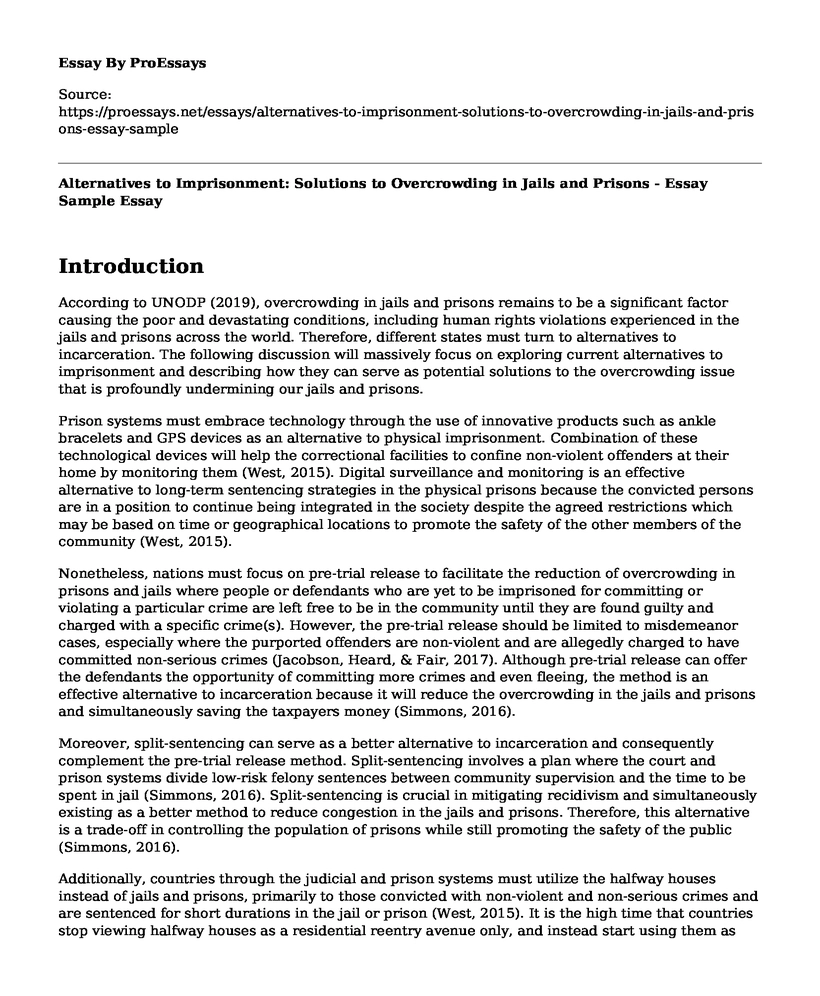Introduction
According to UNODP (2019), overcrowding in jails and prisons remains to be a significant factor causing the poor and devastating conditions, including human rights violations experienced in the jails and prisons across the world. Therefore, different states must turn to alternatives to incarceration. The following discussion will massively focus on exploring current alternatives to imprisonment and describing how they can serve as potential solutions to the overcrowding issue that is profoundly undermining our jails and prisons.
Prison systems must embrace technology through the use of innovative products such as ankle bracelets and GPS devices as an alternative to physical imprisonment. Combination of these technological devices will help the correctional facilities to confine non-violent offenders at their home by monitoring them (West, 2015). Digital surveillance and monitoring is an effective alternative to long-term sentencing strategies in the physical prisons because the convicted persons are in a position to continue being integrated in the society despite the agreed restrictions which may be based on time or geographical locations to promote the safety of the other members of the community (West, 2015).
Nonetheless, nations must focus on pre-trial release to facilitate the reduction of overcrowding in prisons and jails where people or defendants who are yet to be imprisoned for committing or violating a particular crime are left free to be in the community until they are found guilty and charged with a specific crime(s). However, the pre-trial release should be limited to misdemeanor cases, especially where the purported offenders are non-violent and are allegedly charged to have committed non-serious crimes (Jacobson, Heard, & Fair, 2017). Although pre-trial release can offer the defendants the opportunity of committing more crimes and even fleeing, the method is an effective alternative to incarceration because it will reduce the overcrowding in the jails and prisons and simultaneously saving the taxpayers money (Simmons, 2016).
Moreover, split-sentencing can serve as a better alternative to incarceration and consequently complement the pre-trial release method. Split-sentencing involves a plan where the court and prison systems divide low-risk felony sentences between community supervision and the time to be spent in jail (Simmons, 2016). Split-sentencing is crucial in mitigating recidivism and simultaneously existing as a better method to reduce congestion in the jails and prisons. Therefore, this alternative is a trade-off in controlling the population of prisons while still promoting the safety of the public (Simmons, 2016).
Additionally, countries through the judicial and prison systems must utilize the halfway houses instead of jails and prisons, primarily to those convicted with non-violent and non-serious crimes and are sentenced for short durations in the jail or prison (West, 2015). It is the high time that countries stop viewing halfway houses as a residential reentry avenue only, and instead start using them as prisons for non-serious and non-violent offenders. The use of technology, such as video cameras can help the correctional officers to monitor the offenders and ensure that they submit to the courts' set demands and conditions (Simmons, 2016). The halfway houses will enable the convicted persons to work for the community despite the set restrictions and also assist in decongesting the jails and prisons.
Nations around the world must consider implementing alternatives to the usual physical incarceration if they are willing to deal with the overcrowding problem in the jails and prisons. The alternatives as mentioned above to physical imprisonments such as pre-trial release, halfway houses, split sentencing, and digital surveillance and monitoring initiatives among others, will considerably assist in inhibiting overcrowding prisons, improving public safety, and saving on the taxpayers' costs incurred in maintaining the overcrowded jails and prisons.
References
Jacobson, J., Heard, C., & Fair, H. (2017). Prison: evidence of its use and over-use from around the world. Institute for Criminal Policy Research.
Simmons, L. (2016). How to Fix Overcrowded Jails. Stanford Graduate School of Business. Retrieved from https://www.gsb.stanford.edu/insights/how-fix-overcrowded-jails
United Nations Office on Drugs and Crime (UNODP). (2019). Why promote prison reforms? Retrieved from https://www.unodc.org/unodc/en/justice-and-prison-reform/prison-reform-and-alternatives-to-imprisonment.html
West, D.M. (2015). How digital technology can reduce prison incarceration rates. Brookings. Retrieved from https://www.brookings.edu/blog/techtank/2015/03/31/how-digital-technology-can-reduce-prison-incarceration-rates/
Cite this page
Alternatives to Imprisonment: Solutions to Overcrowding in Jails and Prisons - Essay Sample. (2023, Jan 16). Retrieved from https://proessays.net/essays/alternatives-to-imprisonment-solutions-to-overcrowding-in-jails-and-prisons-essay-sample
If you are the original author of this essay and no longer wish to have it published on the ProEssays website, please click below to request its removal:
- Research Paper on YWCA of New York City
- Workers' Protections in the USA - Essay Sample
- Research Paper on Secure Crowd Control for Convention: Ensuring Public Safety While Protecting Rights
- Liberalism Values as Political Ideology Maximizing Well-Being Essay
- Essay Sample on Fox Hunting in Mooreland: Controversy and Exercise
- Essay Example on Coates Refuses to Forgive: A Reflection on Institutional Racism
- Essay Example on Decolonization and Cold War: The New Phase of Imperialism







